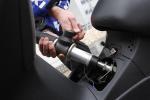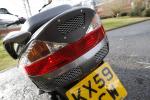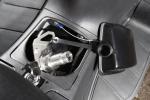Suzuki Fuel Cell Burgman
By Kevin Ash - 25/03/2013
As with so much else to do with climate change, the story being presented about electric two wheelers is rather one-sided.
There‘s good of course: an electric motor can drive the wheel directly so there‘s no need for a gearbox, clutch or auto transmission, or much maintenance either. It produces its peak torque when it‘s not moving, which is ideal for pulling away, it‘s quiet and when powered by batteries the vehicle‘s emissions are zero.
Those are the facts you hear the most, but battery-powered vehicles have failed to take off to date because those batteries are very heavy and use a lot of space - even more of a problem with bikes and scooters than in cars - they can take all night to be recharged and still the range is obstructively small. They also cost a lot of money (the best known electric scooter, the Vectrix, cost some £8,000 until the company went bust, and its range was about 40 miles) and the batteries use rare natural resources.

It‘s deceptive anyway to claim that electric vehicles are zero emission transport. Okay, the scooters themselves might be, but the power to charge the batteries has to come from somewhere, and in the UK with 72 per cent of our electricity being produced in fossil fuel power stations, they can hardly claim to be carbon neutral.
This in itself only matters to those who believe combustion engines are contributing to global warming (or have vested interests in the idea), which just recently in the UK has become a minority (54 per cent are now sceptical, according to a survey for The Daily Telegraph) after a range of scandals and deceits involving climate change scientists. There‘s no question though that fossil fuels are a finite resource and we do need to start finding alternatives before they begin to run out. Which with electricity as the only, er, current option, means either overcoming the problems associated with battery power, or putting up with them.
Suzuki doesn‘t see batteries as a practical solution, which is why it‘s developing a hydrogen fuel cell and battery hybrid drive train, in conjunction with British fuel cell specialist Intelligent Energy. The Burgman I rode is a development of the Crosscage concept bike first seen at the 2007 Tokyo Show (also developed with Intelligent Energy), and it seeks to address exactly the issues which have held back battery vehicles, namely range and recharge times.

On this prototype Burgman the hydrogen fuel is stored under pressure in a 12 litre composite tank beneath the footboard, then piped up to the fuel cell beneath the seat. This generates electricity, producing only water vapour as the waste product. There‘s also a lithium battery, which chimes in to help power the scooter under acceleration, then is recharged by the fuel cell when the loads are less, such as cruising at a steady speed. Further recharging comes from regenerative braking, using the electric motor as a generator when the scooter‘s slowing down.
Intelligent Energy‘s development team is working on balancing the relative sizes of the battery and fuel cell to ensure consistent performance without the battery running flat in normal use. At the moment the cell produces 2kW and the battery 6kW, a total which in more familiar terms comes to about 11bhp, 125cc territory. But already the weight and volume of the system - battery, fuel cell, electric motor and so on - are similar to that of the 125cc Burgman whose performance they are trying to emulate.
One problem is hydrogen leakage. Hydrogen molecules are so small they permeate through fuel tank walls, even steel ones, meaning a scooter left for long enough could be empty when you come back to it. IE‘s Dr Damian Davies says the leakage rate is 5cc per litre per hour, or 60cc per hour from the Burgman‘s 12 litre tank. That‘s 60cc at atmospheric pressure (the tank is at a much higher pressure) so according to Dr Davies while you might notice the fuel gauge had dropped after a couple of weeks of being left, it would take much longer to lose all the hydrogen. If this is factored in as an efficiency loss, the fuel cell is still far more fuel efficient within the vehicle than a petrol engine.

Importantly, Suzuki‘s aim to impose no changes of habits on scooter users - meaning reasonable range and refuelling times - appear to be viable. Filling with hydrogen takes a comparable time to refuelling a petrol scooter, and it‘s not difficult. A nozzle connects to the scooter, and a second earthing clamp to prevent static-generated sparks, then the tank is filled automatically. This takes around double the time of a normal refuel, but still a matter of minutes, enough to light up a ciggie, although that‘s not recommended.
At this stage the range claim is less convincing, as they say it will cover 200 miles (320km) at 19mph (30kph). This is unrealistic, even though it was cited as a typical urban speed, as economy is worse in town than on open roads, not better, due to constant acceleration and braking, and you certainly couldn‘t maintain a steady 19mph on open roads. Even so, a range similar to a petrol scooter should be possible without needing an impossibly large hydrogen tank, and certainly it will be far better than a battery scooter‘s.

Riding the machine is almost disappointingly undramatic, despite the pioneering and unfamiliar new technology. But that‘s exactly how IE and Suzuki want it to be. To ‘start‘ the scooter, turn the ignition key in the usual way, and a quiet background whirr starts as the hydrogen begins to flow. With a helmet on you can‘t really hear it. Next, turn the twistgrip and the Burgman moves smoothly forward, like a conventional scooter without the engine sound. It‘s a little too gentle compared with a 125, but this is due to the electronic control of the motor and it could easily be made more brisk off the line. Then it accelerates and will cruise easily at 30mph (50kph). There was insufficient space to test top speed, but the prototype should reach 50mph (80kph) and a production version about 60mph (95kph).
The water vapour coming out of the back might be visible on cold days, otherwise you can‘t see it, although you can feel some warmth with a bare hand. Everything else is standard scooter, including braking and handling which feel no different - overall this prototype weighs little more than a petrol Burgman 125.. If there‘s a problem it‘s something which is arising regularly with electric vehicles: it can be too quiet. In the long term with enough of them around people will get used to near-silent vehicles, meanwhile there‘s a constant danger of pedestrians stepping out without looking properly, as they can‘t hear anything.

The other issue is refuelling, or more specifically, where to refuel. Hydrogen fuelling points are rare novelties at the moment. There‘s one in Loughborough University, where the demonstration took place, but Boris Johnson says London will have six by 2012, and with a range of major corporations together aiming for a hydrogen commercialisation roll-out for 2015, these numbers will begin to increase dramatically as that time approaches.
No need to fear the process itself if you do find a pump. A nozzle connects to the scooter, and an electrical earthing clamp to prevent static-generated sparks, then the tank is filled automatically. As for cost, Suzuki says it would expect a hydrogen Burgman to come at a small premium over a stock £3,000 125, ie, it would cost more, but not a silly amount extra.
Donate to the Kevin Ash Fund
Kevin's funeral was held on Thursday 28th February 2013 and was well attended by family, friends and colleagues.
The Telegraph has very kindly established The Telegraph Kevin Ash Fund to assist with the education of Kevin's three daughters.
If you'd like to make a donation then you can use the PayPal 'Donate' button below which will allow you to donate from your PayPal account, or via credit or debit card. A small percentage (about 3.4%) will be retained by PayPal for the service.
Kevin's family have been touched by the generosity and messages of support from people using the website and would like to express their gratitude to those who have contributed in any way.
The donations keep coming in, thank you so much, and the family especially like it when you leave a message.
Home | ![]() facebook.com/KevinAshFund
|
facebook.com/KevinAshFund
| ![]() twitter.com/KevinAshFund | © 2013
twitter.com/KevinAshFund | © 2013








